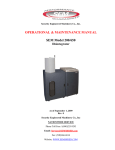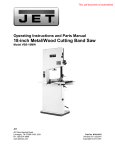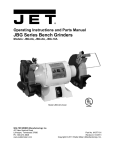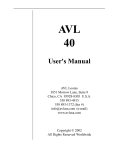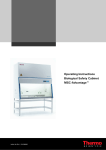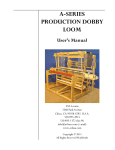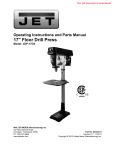Download Trash Compactor
Transcript
Service Manual Trash Compactor Preferred Service This Base Manual covers general and specific information including, but not limited to the following models: FCU150 SMK-0004 FEB 2012 2 Table of Contents Table of contents Safe Servicing Practices....................................................................3-4 Features......................................................................................................5 Grounding Instructions.........................................................................3 Section A – Installation..........................................................................6 Built-in Installation..................................................................................6 Mounting Straps................................................................................6 Under-Counter Opening................................................................6 Cord Clamp.........................................................................................7 Leveling the Compactor.......................................................................7 Section B – Cabinet.................................................................................8 Trash Bucket..............................................................................................9 Remove.................................................................................................9 Door Strap .................................................................................................9 Remove and Replace.......................................................................9 Slide Rails (Cabinet)............................................................................. 10 Remove and Re-install................................................................. 10 Slide Rails (Bucket)............................................................................... 10 Remove and Re-install................................................................. 10 Decorative Door Panel........................................................................ 11 Remove and Re-install................................................................. 11 Door Pan Assembly.............................................................................. 11 Remove and Re-install................................................................. 11 Door Tab.................................................................................................. 12 Remove and Re-install................................................................. 12 Safety Interlock Actuator................................................................... 12 Remove and Re-install................................................................. 12 Gasket Assembly.................................................................................. 13 Remove and Re-install................................................................. 13 Trim Cover Assembly.......................................................................... 14 Remove and Re-install................................................................. 14 Section C – Power Unit Mechanism............................................... 15 Drive Belt ................................................................................................ 16 Remove and Re-install................................................................. 16 Main Motor............................................................................................. 17 Remove and Replace.................................................................... 17 Complete Power Unit Mechanism................................................. 18 Remove and Re-install................................................................. 18 Drive Wheels.......................................................................................... 18 Remove and Replace.................................................................... 18 Ram Screw Assembly.......................................................................... 19 Prepare to Remove and Replace.............................................. 19 Compression Plate Assembly........................................................... 19 Remove and Replace.................................................................... 19 Ram Screw Assembly.......................................................................... 20 Remove and Replace.............................................................. 20,21 Section D – Electrical Components............................................... 22 Access to Components....................................................................... 23 Remove Cabinet Cover.......................................................... 23,24 Re-install Cabinet Cover.............................................................. 25 Control Panel Assembly..................................................................... 25 Remove and Re-install................................................................. 25 Display Module Assembly................................................................. 26 Remove and Re-install................................................................. 26 Power Supply Board............................................................................ 27 Remove and Re-install................................................................. 27 Control Board......................................................................................... 28 Remove and Re-install................................................................. 28 Key Switch............................................................................................... 28 Remove and Replace.................................................................... 28 Interlock Switch Assembly................................................................ 29 Remove and Re-install................................................................. 29 Upper Limit Switch Assembly.......................................................... 29 Remove and Replace.................................................................... 29 Lower Limit Switch.............................................................................. 30 Remove and Replace.................................................................... 30 Motor Centrifugal Switch Assembly.............................................. 30 Remove and Replace.................................................................... 30 Motor Capacitor.................................................................................... 31 Test, Remove and Replace.......................................................... 31 Odor Disk Gear Motor ........................................................................ 32 Remove and Replace.................................................................... 32 Power Cable........................................................................................... 33 Remove and Replace.................................................................... 33 Section E – Troubleshooting Troubleshooting Table........................................................................ 34 Section F – Specifications Specifications Table............................................................................. 37 Section G – Diagrams and Parts List Wiring Schematic................................................................................. 38 Safe Servicing Practices Safe Servicing Practices To avoid personal injury and/or property damage, it is important that Safe Servicing Practices be observed. The following are some limited examples of safe practices. 1. 2. 3. 4. 5. 6. DO NOT attempt a product repair if you have any doubts as to your ability to complete it in a safe and satisfactory manner. Before servicing or moving an appliance, remove the power cord from the electrical outlet, trip the circuit breaker to the OFF position, or remove the fuse. Never interfere with the proper operation of any safety device. USE ONLY REPLACEMENT PARTS CATALOGED FOR THIS APPLIANCE. SUBSTITUTIONS MAY DEFEAT COMPLIANCE WITH SAFETY STANDARDS SET FOR HOME APPLIANCES. GROUNDING: The standard color coding for safety ground wires is GREEN, or GREEN WITH YELLOW STRIPES. Ground leads are not to be used as current-carrying conductors. It is EXTREMELY important that the service technician re-establish all safety grounds prior to completion of service. Failure to do so will create a hazard. Prior to returning the product to service, ensure that: • All electrical connections are correct and secure • All electrical leads are properly dressed and secured away from sharp edges, high-temperature components, and moving parts • All non-insulated electrical terminals, connectors, heaters, etc., are adequately spaced away from all metal parts and panels • All safety grounds (both internal and external) are correctly and securely connected • All panels are properly and securely re-assembled NOTE This service manual is intended for use by persons having electrical and mechanical training and a level of knowledge of these subjects considered acceptable in the appliance repair trade. Viking Range Corporation cannot be responsible, or assume any liability, for injury or damage of any kind arising from the use of this manual. Grounding Instructions FOR PERSONAL SAFETY, THIS APPLIANCE MUST BE PROPERLY GROUNDED. This power cord on this appliance is equipped with a three-prong (grounding) plug which mates with a standard three-prong (grounded) receptacle. If there is a two-prong outlet located where you will install the compactor, it is your responsibility to have it replaced with a properly grounded three-prong wall receptacle. DO NOT, UNDER ANY CIRCUMSTANCES, CUT OR REMOVE THE THIRD (GROUND) PRONG FROM THE POWER CORD. A 120-volt, 60 Hz., A.C., 15 amp fused and grounded electrical supply is required (time-delay fuse or circuit breaker is recommended). It is recommended that a SEPARATE CIRCUIT serving only this appliance be provided. DO NOT USE AN EXTENSION CORD WITH THIS APPLIANCE. 3 4 Safe Servicing Practices SAVE THESE INSTRUCTIONS REVIEW ALL SERVICE INFORMATION IN THE APPROPRIATE SERVICE MANUAL AND TECHNICAL SHEETS BEFORE BEGINNING REPAIRS. Pride and workmanship go into every product to provide our customers with quality products. It is possible, however, that during its lifetime, a product may require service. Products should be serviced only by a qualified service technician that is familiar with the safety procedures required in the repair and who is equipped with the proper tools, parts, testing instruments, and the appropriate service manual. Safety Information We have provided many important safety messages in this manual and on the appliance. ALWAYS read and obey all safety messages. This is the safety alert symbol. All safety messages will identify the hazard, tell you how to reduce the chance of injury, and tell you what can happen if the instructions are not followed. This symbol alerts you to hazards that can kill or hurt you and others. All safety messages will be preceded by the safety alert symbol and the word “DANGER”, “WARNING”, or “CAUTION”. These words mean: To locate an authorized servicer, call: Viking Customer Service Phone No. 1-888-845-4641 Address your written correspondence to: Viking Preferred Service 1803 Hwy 82 West Greenwood, MS 38930 5 Features Electrical components (SECTION D) Power Unit Mechanism (SECTION C) Cabinet (SECTION B) How the compactor works The compactor compresses household trash up to 1/6 of its original volume. It will compact normal household trash including milk cartons, glass and plastic bottles, containers and jars, tin cans, wrappings, boxes, food wastes, etc. When you start the compactor, an electrically powered ram moves down into the trash bucket, compresses the trash and then returns to the “UP” position and shuts off automatically. NOTE: The ram travels about 2/3 of the way down into the trash bucket. Because of this, the trash bucket must be at least 1/3 full before you will notice any compression. 6 Section A – Installation Your compactor has been designed to require minimum space without loss of capacity. Built-in Installation mounting straps under-counter opening 15" w 24" d 345/8" h top of compactor front of compactor 12" MIN Opening electrical 15" Wide outlet 34-1/2" High 22" Deep Two under-counter mounting straps are provided. Use these straps to secure the compactor to the underside of a countertop. The compactor requires an under-counter opening 15-in. wide, 34-5/8-in. high, and 24-in. deep. Fasten the slotted end of the straps to the compactor using the holes in the top of the compactor cabinet as shown. Plan to provide an electrical outlet in the opening that meets all applicable electrical codes and requirements. See “Grounding Instructions” on Page 2 for specific information. NOTE: When installation compactor under granite or solid surface countertops, bend the mounting straps so they can be secured to the adjacent cabinetry. 7 Section A – Installation Leveling the Compactor Cord clamp The compactor is equipped with a 6-ft. long power cord. Use the cord clamp to prevent excess power cord from being pinched beneath the cabinet during installation or service. Your compactor has four adjustable levelers; (2) rollers in the rear and (2) legs in the front. They allow you to adjust for uneven floors and also trim the unit up to fit an undercounter installation. back of compactor slots adjusting screws cord clamp wood block rollers To level the back of the compactor: Tip the back of compactor up and onto a wood block. Loosen the adjusting screws only far enough to move the rollers to a higher or lower slot. Retighten the adjusting screws and remove the wood block. front of compactor wood block leveling legs To level the front of the compactor: Tip the front of compactor up and onto a wood block. Turn the leveling legs in or out to the desired position. Remove the wood block. 8 Section B – Cabinet A I C, D G E Cabinet Legend The compactor’s main cabinet supports and encloses a number of sub-assemblies. These include the trash bucket, the door, the motor, the ram, and the electrical controls and components. A. B. C, D. E. F. G. H. I. B H F Trash Bucket Trash Bucket Door and Slide Pan Slide Rails Door Pan Assembly (Includes Door Tab) Decorative Door Panel with Handle Door Strap Safety Interlock Actuator Gasket Assembly 9 Section B – Cabinet Trash Bucket Door Strap Remove Remove and Replace To remove the bucket completely from the cabinet for repairs or cleaning, follow these instructions. Should either door strap become damaged, replace with a new one. Trash bucket door 1. 3. bucket slide release tab screw Pull out trash bucket until it stops. 2. Remove one screw from each of the bucket slides. 3. Press down on left and right bucket slide release tabs while pulling the bucket out of the cabinet. spacer Door Bolt strap 1. Remove the bolt and spacer that attach the door strap to the side of the trash bucket door. 2. Remove the strap by sliding the keyhole area of the slotted hole over the button. 3. Install the replacement door strap on the button and align the bolt hole with the hole in the trash bucket door. 4. Hold the spacer in position between the trash bucket and the strap. Secure with the bolt. 2. 1. BUTTON 10 Section B – Cabinet Slide Rails (Cabinet) Slide Rails (Bucket) Remove and Re-install Remove and Re-install The compactor’s slide rails may become bent from misuse or the ball bearings may become worn. Rail Spring Clips Screw Rail Screw Bucket Nut Screws Screws 1. Remove trash bucket assembly. (See Trash Bucket, Remove.) 2. Remove two Phillips head screws from the front and rear of the left track slide rail. NOTE: It is necessary to slide the inner rail to access both screws. 3. Remove the slide rail from the cabinet. 4. To re-install, place slide rail onto the three “spring clips” inside of the cabinet. Align holes in rail with bracketed holes on inside of cabinet and secure with two Phillips head screws. Repeat for other side. 1. Remove four Phillips head screws that secure the left slide rail to the bucket. Remove the rail. 2. Repeat Step 1 for the right slide rail. 3. Installation is the reverse of removal. 11 Section B – Cabinet Decorative Door Panel Door Pan Assembly Remove and Re-install Remove and Re-install Should the Viking decorative door panel with handle become damaged, replace it with a new one. Removing the decorative door is also essential for servicing the compactor’s door pan. The door pan assembly may be removed if necessary for trash compactor service. 5 Flat Head Screws Door Pan Assembly Door Pan Assembly Trash bucket Door Decorative Door Panel 4 Screws 2 Locator Clips 1. Remove the five flat head screws that attach the decorative door panel to the door pan assembly. 2. Firmly pull the decorative door panel away from the door pan to disengage the two locator clips. 3. Position the replacement decorative door panel in place by snapping the two locator clips into the corresponding door pan holes. 4. Secure the decorative door panel with the five flat head screws. 8 Flat washers 4 Lock washers 1. Remove the decorative door panel to access the door pan assembly. 2. Remove the four Phillips head screws, four lock washers, and eight flat washers that attach the door pan assembly to the trash bucket door. 3. Re-install using the same hardware. Make sure there is a flat washer on both sides of each of the four holes in the door pan assembly as shown in the illustration. 12 Section B – Cabinet Door Tab Safety Interlock Actuator Remove and Re-install Remove and Re-install The door tab prevents the door pan assembly from being raised and unlatched while the compactor is operating in auto delay mode. If the door tab is chipped or broken, replace it. This safety device prevents the compactor from operating except when the door is closed. NOTE: If the interlock actuator should break off, the compactor will not function; replace it promptly. Door Pan Assembly Door Pan Assembly Decorative Door Panel Decorative Door Panel Actuator 2 Screws 1. Door Tab Remove the decorative door panel (see Cabinet, Decorative Door Panel) to access the door pan assembly. 2. Remove the two Phillips head screws that attach the door tab. 3. Re-assemble in reverse order. 1. Remove the decorative door panel (see Cabinet, Decorative Door Panel) to access the door pan assembly. 2. Remove the damaged actuator. 3. Push the replacement actuator in place on the door pan. NOTE: Confirm that the actuator is fully seated. 4. Re-install the decorative door panel. 13 Section B – Cabinet Gasket Assembly 1. Remove door assembly (see Door Assembly, Remove and Re-install). Remove and Re-install 2. Remove control panel (see Electrical Components, Control Panel Assembly). 3. Lift the outer edge of the gasket to expose the retainer strips and the screws that are used to fasten the strips to the cabinet. NOTE: There are six retainer strips: two each on the top and bottom and one each for the left and right sides. 4. Remove the Phillips head screws that secure the retainer strips to the cabinet; then remove the strips from underneath the gasket. Pull the gasket off of the cabinet. 5. To install a new gasket, place retainer(s) under the outer edge of the gasket, then use the screws to fasten the retainers and gasket to the cabinet. 6. Re-install the control panel. The gasket is made of a flexible vinyl material with imbedded magnets. Over time it may become brittle or cracked, and lose its flexibility. If this happens the door may not close properly, so replace the gasket. TRIM COVER CABINET GASKET SCREWS RETAINER STRIPS 14 Section B – Cabinet Trim Cover Assembly Remove and Re-install TABS Trim Cover Gasket 1. Remove door (see Door Assembly). 2. Using a flat-head screwdriver, gently pry the first of four tabs of the top trim cover away from the side of the cabinet. After you have pried off the first tab, gently grasp the cover and pry away the other three tabs in order, one at a time, to completely remove the cover. Section C – Power Unit Mechanism A b D F C E Legend A. B. C. D. E. F. Drive Belt Main Motor Complete Power Unit Mechanism Ram Screw Assembly Compression Plate Compression Plate Pad 15 16 Section C – Power Unit Mechanism Drive Belt Drive Wheels Remove and Re-install The drive belt transfers power from the motor to the ram screws. If it requires replacement, follow these steps. 4 Cover Screws BELT COVER CAP Screws BELT 3. Use a 5 mm hex wrench to loosen the three hex head cap screws. Rotate motor to loosen belt for removal. IMPORTANT: Before installing a new drive belt, follow the instructions below to align the height of both ram screws. Top Frame 3 Motor Screws RAM SCREWS 1. 2. Remove cabinet cover (see Electrical Components, Access to Components). Remove the four Phillips head screws that secure the belt cover to the unit. 4. Measure the distance from the underside of the top frame to the bottom edge of the ram at the front and rear of the power unit. 5. If the measurements are different, rotate the ram screw drive wheels as necessary until the measurements match. 6. Install new belt, making sure it seats properly in gear teeth. Adjust the belt tension by rotating the motor until the belt deflection is 1/2 inch. Tighten the three hex head cap screws securely. Re-install the belt cover. 17 Section C – Power Unit Mechanism Main Motor Remove and Replace Follow these instructions if it becomes necessary to replace the main motor. DRIVE WHEEL Idler Wheel MOTOR IDLER WHEEL 1. Remove cabinet cover (see Electrical Components, Access to Components). 2. Remove the belt cover and drive belt (see above) and follow the steps in Drive Belt, Remove and Re-install. 3. Mark the location of all wire connections and ties on the motor, then disconnect the wires. 3 HEAD CAP SCREWS, LOCK WASHERS AND FLAT WASHERS NOTE: For illustration purposes, the view is shown with the drive wheels removed. 4. Use an open-end, socket or crescent wrench to remove the idler wheel. 5. Support the motor from underneath and remove the three head cap screws, lock washers and flat washers. Remove the motor. 6. Re-assemble in reverse order. Adjust the belt tension by rotating the motor until the belt deflection is 1/2 inch. 18 Section C – Power Unit Mechanism Complete Power Unit Mechanism Drive Wheels Remove and Replace Remove and Re-install SPRING WASHER The complete power unit mechanism consists of the ram screw assemblies, the motor and the drive belt. Rather than replace individual components, it may be easiest to replace the whole mechanism. BEARING THRUST WASHER DRIVE WHEEL Screws IDLER WHEEL SUPPORT ROD 3 SCREWS MOTOR 1. Remove cabinet cover (see Electrical Components, Access to Components). 2. Mark the location of all wire ties. screws 3. Support the power unit and remove the two Phillips head screws from each of four support rods. 4. Remove the power unit mechanism. 5. Installation is the reverse of removal. 1. Remove cabinet cover (see Electrical Components, Access to Components). 2. Remove the belt cover and drive belt (see above) and follow the steps in Drive Belt, Remove and Re-install. 3. Remove spring washer, bearing and thrust washer from each drive wheel and remove both drive wheels. NOTE: Grease the spring washer, bearing and thrust washer before re-installing. 19 Section C – Power Unit Mechanism Ram Screw Assembly Compression Plate Assembly Prepare to Remove and Replace Remove and Replace The ram screw assemblies transfer power to the ram and plate. Heavy usage can damage the threaded rod. If it becomes necessary to replace one or both of the ram screw assemblies, follow the instructions below. Remove the compression plate assembly from the ram screw assembly. The compression plate pad may need replacement if it is damaged or causing trash bag tears. 1. Remove cabinet cover (see Electrical Components, Access to Components). 2. Remove the drive belt (see Drive Belt, Remove and Re-install). 3. Remove drive wheels (see Drive Wheels, Remove and Replace). Screws Compression plate assembly Compression Plate Pad Compaction Plate 4. RAM Release Tab Remove the compaction plate by releasing the tab on the front of the ram, and pulling the plate down and away from the ram. Note: When re-installing the plate, insert the rear tab into the slot at the rear of the ram, then press up on the front of the plate until it latches securely in place. Ram Screw Assembly 3 Flat Head Screws Compression Plate TAB 4 Screws 1. Remove the four hex head screws and the compression plate from the bottom of the ram screw assembly. 2. Remove the three flat head screws to remove and replace the compression plate pad. 20 Section C – Power Unit Mechanism Ram Screw Assembly Fasteners Remove and Replace Once the compression plate assembly is removed, continue with ram screw removal and disassembly. Pin Fasteners 1. Remove two hex head screws, shims, brackets and nuts (fasteners) from the top of the ram screw assembly. Note orientation of bracket during removal as they activate the limit switches. Pin Slot 2. Turn the ram until the top pin indexes 90° from the pin slot; remove two hex screws, lock washers and flat washers (fasteners). 3. Turn the ram as required to align the ram pin with the slot in the top frame and lower the ram through the hole. 21 Section C – Power Unit Mechanism Thrust Washer Bearing Bearing Housing Top Pin Ram Screw Thrust Washer PIN Bearing Bearing Housing 4. Remove the pin, thrust washer, bearing, and upper bearing housing from the ram. 5. Lower the ram screw assembly through the center stabilizer plate. NUT Stabilizer Plate SCREW Brackets Lower ram Screw Housing BOSSES Notches IMPORTANT: On re-assembly, index the bosses on the top bearing housing with the corresponding notches in the bearing. Brackets must be positioned correctly as they activate the limit switches. See illustration at left. 6. Re-assembly is the reverse of disassembly. 22 Section D – Electrical Components F a G B H I J, K Legend A. B. C. D. E. F. G. H. I. J. K. L. Cabinet Cover Control Panel Assembly Display Module Assembly Power Supply Board Control Board Cabinet Safety Interlock Switch Key Switch Assembly Upper Limit Switch Assembly Lower Limit Switch Motor Centrifugal Switch Assembly Motor Capacitor Odor Disk Gear Motor Assembly c, d, e L 23 Section D – Electrical Components Access to Components In order to access the electrical components, it is first necessary to remove the cabinet cover. Remove Cabinet Cover 1. Remove the bucket from the compactor (see Cabinet, Trash Bucket). 2. Remove the back panel by first removing the Phillips head screw that secures the power cord cable clamp to the back panel, and then removing the 16 screws that secure the panel to the cabinet. Screws Screws Screw Bag Storage Cable Clamp NOTCH 4. Control Panel Back Panel Screws Screws 3. Remove control panel assembly (see Control Panel Assembly, Remove and Re-install). Screws NOTCH To remove the bag storage, remove four Phillips head screws that secure it to the cabinet. Note: Upon reassembly, the notches on the right and left sides must appear on the lower part of the bag storage. 24 Section D – Electrical Components SCREWS 7. Remove five Phillips head screws each from the lower right and left sides of the cabinet cover. Screws 5. Remove six Phillips head screws each that secure the front and rear of the stabilizer plates to the cabinet cover (rear view shown). Stabilizer Plates 8. Gently spread lower left and right sides of the cabinet cover apart and raise a few inches to allow the left and right stabilizer plates to be removed. Take care not to damage or tear the gasket. Tilt the bottom front of the cabinet cover forward and up while raising the cover. 9. Grasping the front and rear edges of the cover, raise it up a few inches and allow it to rest temporarily on the four locator pins. Remove the left and right stabilizer plates. Again grasp the front and rear edges of the cover and lift it off the unit, tilting it forward and back as required. Grommet 6. To remove the power cord at the back of the unit, rotate the power cord grommet 90º to the right, then slide the cord out of the slot. Temporarily place the cord in the rear of the power unit assembly to keep it out of the way. Section D – Electrical Components Re-install Cabinet Cover Pins Control Panel Assembly Remove and Re-install The control panel assembly houses the display panel, the safety interlock switch, the battery backup compartment, the bag storage, and the odor control disk tray. Screws 1. To re-install the cabinet cover, lift the cover over the top of the unit and allow it to rest temporarily on the top of the locator pins. 2. Insert the right and left stabilizer plates but do not secure them in place (they will rest temporarily on top of the ram). Gently move the cover so that the front and rear pins slide into their respective rubber grommets. 3. Using six Phillips head screws (front and rear), secure the three stabilizer plates to the cabinet. NOTE: The stabilizer plates rest below the front and rear crossmembers (see illustration above). 4. Re-install the bag storage, control panel, cabinet cover, bucket and door, etc., in reverse order. Control Panel 25 26 Section D – Electrical Components Display Module Assembly Remove and Re-install The display module assembly contains switches and LEDs that allow the operator to turn the compactor ON and OFF, and to place it in LOCK mode; to select HOLD or NORMAL mode; to start the compactor cycle; to set the clock and delay mode; and to monitor odor control, and to reset and advance the odor control disk. If LEDs or switches are worn, replace the display module. 1. Remove the control panel assembly from the unit (see Control Panel Assembly, Remove and Re-install). Screws 1. On the front of the unit, remove the five Phillips head screws that secure the control panel assembly to the cabinet cover. Wiring Harnesses Odor Disk Switch 2. Battery Connector Disconnect the battery connector and odor disk switch from the control panel. Wiring Harnesses 2. After removing these five screws, pull the panel away from the cabinet and disconnect the three wiring harnesses. 3. Installation is the reverse of removal. Screws 3. Remove five Phillips head screws and the display module assembly from the control panel. 4. Installation assembly is the reverse of removal. NOTE: First install display module assembly to panel, then re-attach wiring. 27 Section D – Electrical Components Power Supply Board Interlock Switch Wire Remove and Re-install The power supply board directs electrical power to all areas of the compactor, including the control board, the main motor and the odor control motor. Display Panel Screws Control Board Screws Control Panel 1. Power Supply Board Key Switch Wires Control Board Harness Rear Cover 3. Lifting the cover and noting their locations, firmly but gently disconnect the control board harness, the wire at the interlock switch, and the key switch wires. Remove the rear cover. NOTE: Illustration does not show control board insulator. Remove the control panel and display module assembly (see Control Panel Assembly, Remove and Re-install and Display Module Assembly, Remove and Re-install). Screws Screws 2. Remove four Phillips head screws from the display module assembly rear cover. 4. Remove four Phillips head screws and the power supply board from the rear cover. 5. Installation is the reverse of removal. 28 Section D – Electrical Components Control Board Key Switch Remove and Re-install Remove and Replace The control board is used to electronically connect the compactor’s electronic components. Part mechanical, part electrical, the key switch gives the operator three options: ON, OFF and LOCK. Control Panel Control Panel Screws Control Board Interlock Switch Screws Key Key Switch Assembly Display Panel 1. Remove the control panel assembly (see Control Panel Assembly, Remove and Re-install). Remove rear cover from the display module assembly (see Display Module Assembly, Remove and Re-install). Display Module 1. Remove the control panel assembly (see Control Panel Assembly, Remove and Re-install) and the display module. Remove the display module rear cover and the key. Switch Assembly Wire Connector Screws Screws 2. Remove the wire harnesses from control board (Note wire locations). Note: In this illustration, the key switch and control board insulator have been removed for clarity. NOTE: In this illustration, the control board insulator has been removed for clarity. 2. Remove three Phillips head screws and lift the switch assembly away from the housing. 3. Remove six Phillips head screws, the printed circuit board, and the insulator from the display module frame. 3. Noting their locations, transfer the wires to the replacement switch. 4. Installation is the reverse of removal. 4. Installation is the reverse of removal. 29 Section D – Electrical Components Interlock Switch Assembly Upper Limit Switch Assembly Remove and Re-install Remove and Replace The interlock switch assembly is a safety feature. The switch prevents the compactor from operating unless the door is safely closed. This switch sets the upper travel limit for the ram mechanism. 1. 1. Remove the control panel assembly from the unit (see Control Panel Assembly, Remove and Re-install). Remove the back panel from the cabinet cover (see Access to Components, Remove Cabinet Cover). Wires Screws Screws 2. Noting their locations, transfer the wires to the replacement switch assembly. 3. Remove two Phillips head screws and the interlock switch assembly from the display panel. 4. Installation is the reverse of removal. 2. Remove four Phillips head screws that secure the switch assembly bracket to the top frame, and remove the switch assembly. 3. Noting their locations, transfer the wires to the replacement switch assembly. 4. Install the switch assembly and secure with four Phillips head screws. 30 Section D – Electrical Components Lower Limit Switch Remove and Replace This switch sets the lower travel limit for the ram mechanism. 1. Remove the back panel from the cabinet cover (see Access to Components, Remove Cabinet Cover). Motor Centrifugal Switch Assembly Remove and Replace This switch reverses the motor when peak load is reached. Power Unit Mechanism Switch Screws Screws 2. Remove two Phillips head screws and the switch from the center stabilizer plate. 3. Noting their locations, transfer the wires to the replacement switch. 4. Install the switch and secure with two Phillips head screws. 1. Remove the control panel assembly from the front of the unit (see Control Panel Assembly, Remove and Re-install). Screws 2. Remove two Phillips head screws and the switch from the bottom of the motor. 3. Noting their locations, transfer the wires to the replacement switch. 4. Install the switch and secure with two Phillips head screws. 31 Section D – Electrical Components Motor Capacitor Test, Remove and Replace Power Unit Main Motor Screws 2. Capacitor Shield Locate the capacitor underneath the main motor. Remove three Phillips head screws and the shield. Shield Screws The capacitor provides power required to start the main motor and improves overall efficiency. Use an electrically-insulated tool to short the capacitor terminals together. This will ensure the capacitor has fully discharged and will prevent shock if any body part comes in contact with the terminals. Before testing with a multi-meter, there are two indicators you can look for on the outside of the capacitor to see if it is bad. If you spot corrosion around the terminals or bulging electrolyte (ceramic outer material), then the capacitor is leaky and must be replaced. To access and test the capacitor: 1. Remove the control panel assembly from the front of the compactor (see Control Panel Assembly, Remove and Re-install). Screws Wire Leads 32 Section D – Electrical Components 3. Remove two Phillips head screws and wire leads from the capacitor. Odor Disk Gear Motor 4. Discharge the capacitor (see Warning above). Remove and Replace 5. Use an ohmmeter or multi-meter set on the “Ohms times 1000” scale (if available) to check resistance across the wire terminals. The needle should jump toward zero ohms and quickly move back to infinity. (Note: Some less-sophisticated meters will only tell you if the capacitor is good or bad.) It is rare that this motor wears out because it operates just once a month (more if operated manually). If it should require replacement, follow the instructions below. 6. If the needle does not move, if the needle reads a constant value or near zero ohms, or if the needle jumps toward zero and then moves back to constant high resistance (not infinity), replace the capacitor. 7. Installation is the reverse of removal. Note: On installation, route the wires through the notches in the shield. Motor Stabilizer Plate Screws 1. Before servicing this item place ram in lowest position by setting compact mode to hold. Press start button and close door. Ram will run down and stop. Disconnect power. 2. Open bucket door. 3. Remove the control panel assembly from the front of the compactor (see Control Panel Assembly, Remove and Re-install). 33 Section D – Electrical Components Power Cable Remove and Replace If the power cable becomes worn or frayed, replace it. Screws 4. Remove two Phillips head screws (in above illustration, shown in place from the top) from the bottom of the right stabilizer plate and remove the odor disk gear motor. 5. Reassemble unit in reverse order. Ground Screw Grommet 1. Remove the back panel from the compactor (see Access to Components, Remove Cabinet Cover). 2. Rotate the power cord grommet 90° and slide it out of the slot in the cabinet frame. 3. Remove the screw securing the cord’s green ground wire to the frame. 4. Cut the black and white power cord wires beyond the crimp connectors and remove the cord. 5. Strip, connect and crimp the black and white wires of the replacement cord to the unit per the electrical schematic on the inside of the back panel (or in this manual). 6. Attach the cord’s green ground wire to the top frame, and secure with the original screw. The standard color coding for safety ground wires is GREEN, or GREEN WITH YELLOW STRIPES. Ground leads are not to be used as current-carrying conductors. It is EXTREMELY important that the service technician re-establish all safety grounds prior to completion of service. Failure to do so will create a hazard. 7. Install the grommet on the cord and insert in cabinet frame. 8. Re-install back panel. 34 Section E – Troubleshooting Troubleshooting Table Problem No power to compactor. Compactor will not operate. Possible Cause 1. Power cord not securely plugged in. 2. House fuse blown or circuit breaker tripped. 1. Key switch in OFF or LOCK position. 2. Safety interlock switch not engaged when door is closed due to a: a. Broken actuator. b. Debris prevents door from closing. c. Damaged or deformed door. d. Gasket damaged preventing door from closing. 3. Safety interlock switch assembly defective. 4. Key switch defective. 5. Defective control module. 6. 7. Unable to open or close trash bucket. 1. 2. 3. 4. 5. Trash bags pull down into trash bucket. 1. 2. Correction 1. Securely plug in cord. 2. 1. Replace fuse or reset circuit breaker. Turn key switch to ON position. 2. a. b. c. d. 3. 4. 5. After repeated use, the compactor motor’s automatic thermal cutout may have engaged. Motor defective. 6. Slide rail(s) damaged. Trash bucket damaged or bent. Debris wedged between cabinet and trash bucket. Trash bag caught on ram. 1. 2. 3. Ram is in down position. AUTO DELAY is active. Using trash bags designed for another manufacturer’s compactor. Improper installation of trash bag. 5. 7. 4. 1. 2. Replace actuator. Remove debris and ensure door closes properly. Replace door. Replace gasket. Replace interlock switch assembly. Replace key switch assembly. Replace control board or complete display module assembly. Wait a few minutes to allow unit to cool down; cutout will reset itself. Replace motor or complete power mechanism. Replace rail(s). Replace trash bucket assembly. Remove debris. Remove trash bag from ram. It may be necessary to replace the trash bag if it has been damaged. NOTE: It is recommended to fill each new trash bag completely before compacting for the first time. Wait for AUTO DELAY period to end. Use Electrolux replacement trash bags. Install trash bag correctly. Refer to trash compactor use and care guide for installation instructions. 35 Section E – Troubleshooting Troubleshooting Table (Continued) Problem Noticeable odor coming from trash compactor. Deodorant disk auto advance feature does not function During compaction cycle the motor runs but the ram doesn’t move. Compactor does not compact cans or bottles. Compaction force appears weak. Possible Cause 1. Active section of deodorant disk has expired. 2. Entire deodorant disk has expired. 3. Odor causing trash is trapped outside of the trash bucket. Correction 1. Advance deodorant disk to next section. 2. Replace deodorant disk. Drive belt is damaged. Clean or remove odor causing trash. Check behind the trash bucket and on top of the ram. NOTE: It is recommended to place folded sheets of newspaper on top of the trash when compacting messy food waste or items that may shatter to keep the trash compactor compartment clean and in good working order. 4. Replace door gasket. 1. Replace auto advance motor assembly. 2. Replace control board or complete display module assembly. 3. Replace power board or complete display module assembly. Replace drive belt. 1. Insufficient amount of trash in trash bucket. 1. 2. Bottles or cans are arranged too uniformly. 2. 3. Lack of lubrication on moving components. 3. 4. Compaction plate not installed. 4. 4. 1. 2. Damaged door gasket. Auto advance motor is defective. Defective control board. 3. Defective power board. 3. Ram does not travel to bottom of trash bucket. Ensure trash bucket is at least half full before compacting. Compaction results will improve as more trash is added. Bottles and cans should be placed randomly in center of drawer. Cans and bottles neatly arranged are capable of supporting a tremendous amount of pressure. Inspect power mechanism and regrease components on mechanism as necessary. NOTE: It is recommended to use high quality wheel bearing grease. Install compaction plate. 36 Section E – Troubleshooting Troubleshooting Table (Continued) Problem Compactor stops during operation. Possible Cause 1. Uneven load may cause trash bucket to shift forward opening the door. 2. Compaction cycle repeats without pressing START. After pressing START and closing the door, ram reverses direction repeatedly for 3 seconds and shuts off. Ram runs down for 3 seconds and motor stops. Control board defective. 1. 2. Lower limit switch defective. Centrifugal switch defective. 1. Defective upper limit switch assembly. Defective centrifugal switch. 2. Motor hums after ram returns to the up position. Ram continues to run with the door open. Ram runs down and doesn’t return up. Motor hums after reaching the bottom position. Ram runs down and stops (operates as it would in AUTO DELAY compact mode). Trash compactor noise level increases during operation. NOTE: Due to the number of moving components, it is expected that operating noise may increase over the life of the product. Uneven load may cause ram to wedge in trash basket. Defective upper limit switch assembly. Defective interlock switch. Correction 1. Gently push the door closed until the door actuator engages the interlock switch. This will activate the ram until it returns to the up position. Open trash bucket and reposition any objects that may be causing the uneven load. 2. It may be necessary to remove cabinet and reverse screw assemblies manually. Replace control board or complete display module assembly. 1. Replace lower limit switch. 2. Replace centrifugal switch assembly. 1. Replace upper limit switch assembly. 2. Replace centrifugal switch assembly. Replace upper limit switch assembly. Replace interlock switch assembly. Defective upper limit switch assembly. Replace upper limit switch assembly. Control board defective. Replace control board or complete display module assembly. 1. Worn or damaged drive components. 1. 2. Lack of lubrication on moving components. 2. Inspect power mechanism and replace damaged or worn components. Inspect power mechanism and regrease components on mechanism as necessary. It is recommended to use high quality wheel bearing grease. 37 Section F – Specifications Specifications Table Viking Trash Compactor Model FCU150 Volts 120 Hz 60 Amps 5.0 Capacity 1.55 ft.3 30 lbs. Compactor 3000 lbs. 6 to 1 Weight Dimensions 165 lbs. (packaged) 34-3/8" H (min.) 14-7/8" W 22" D Section G – Diagrams and Parts Lists Wiring Schematic DOOR SENSOR SWITCH BLACK ODOR DISK SENSOR SWITCH WHITE BLACK WHITE RAM UP SENSOR SWITCH BLACK BLACK RED RAM LOCK SWITCH RED DC 9V BATTERY BACK-UP USER INTERFACE MAIN MOTOR MOTOR CENTRIFUGAL SWITCH BLUE BLACK MOTOR PROTECTOR WHITE START DOWN RED BLACK RED 200MFD 125VAC LOWER LIMIT SWITCH RED WHITE START UP WHITE UPPER LIMIT SWITCH DOOR INTERLOCK SWITCH RUN BLACK/WHITE YELLOW BLACK ORANGE 38 BLUE UPPER LIMIT SWITCH BLACK/WHITE KEY SWITCH WHITE WHITE WHITE 0V BROWN BLACK 120V SCHEMATIC SHOWS UNIT WITH RAM IN “UP POSITION”, KEY SWITCH “OFF”, DOOR “OPEN”, AND COMPACT MODE “NORMAL”. BLUE GREEN START RELAY YELLOW COMPACT MODE RELAY ORANGE RED BROWN DC 24V MOTOR BLACK BROWN ORANGE POWER PCB SWITCH RED






































